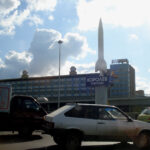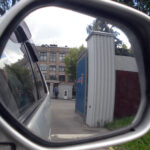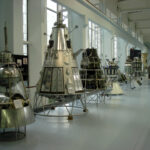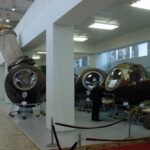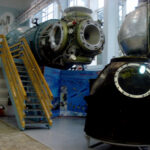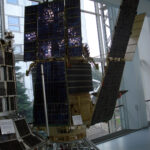Quick Guide, description and additional information to the pavilion “Soviet and Russian Space” in the Museum of Aviation and Space in Le Bourget near Paris.
- Museum of Aviation and Cosmonautics in Le Bourget Travel Guide, Pavilion “Soviet and Russian Space, as well as France, Germany and the USA.
According to the official version, the entire Soviet space was peaceful, and there were no space troops. Of course, this is an obvious lie of the communist party and the Soviet government, exposed after the collapse of the USSR. All, or almost all, space was military and was used for the needs of the Soviet Army, Navy and KGB with minor scientific research for civilian purposes.
The ideas and calculations of human flight into space were laid down before 1917 by the Russian scientists K. Tsiolkovsky and F. Zander, but the First World War and the revolution slowed down the work. The Land of Soviets dreamed of making a revolution throughout the world and building a communist society. Therefore, rocket science developed with a practical goal – to create a carrier of bombs over long distances. After the civil war, the surviving engineers emigrated from Russia to the United States, such as the designer of aircraft and helicopters I. Sikorsky. During Stalin’s Great Terror against his people, many engineers were shot as “enemies of the people”, and even more were imprisoned, such as aircraft designers Tupolev and even Korolev. The death in the Gulag of these NKVD engineers was proposed to be replaced by a special prison for scientists – “Design Bureau” or “Sharashka”. To survive, the engineers had to create the latest weapons for the Land of Soviets under the leadership of the NKVD. The Soviets did not need flights to the Moon, more practical results of rocket science were required. Before World War II, the legendary Katyusha, the BM-13 Fighting Vehicle, was built. In the battle for Moscow, BM-13 missiles successfully destroyed communications and echelons of the German invaders. More about the BM-13… Germany also built rocket-propelled mortars, unofficially named “Vanyusha” (Ivan, who will have Katyusha).
Throughout the Second World War, the Third Reich worked on the creation of long-range missiles to destroy British cities, primarily London as the base of the “allies”. Near the bottleneck of the English Channel, the Germans built several secret underground factories for building and launching V-class ballistic missiles. We offer our BB2 battlefield tours with visits to secret factories and museums dedicated to the theme of rocketry and bombardment of the UK.
Some of the projects were fantastic, some were real. The Allied landing in Normandy on D-Day, the liberation of France, stopped Germany’s work on the creation of intercontinental ballistic missiles, but the creation of a nuclear bomb continued. The combined defeat of the Third Reich, the division of Europe into two zones of occupation, and the outbreak of the Cold War sparked a hunt for Nazi secret weapons. US Army Colonel Boris Pash (Pashkovsky), a former officer of the White Army, an implacable enemy of the Soviets, found and delivered to America secret documentation and German scientists working on the creation of a nuclear bomb. The “weapon of vengeance” now had to work against the Soviets already under the control of the US Army.
Employees of the NKVD also found and exported to the USSR technical documentation, scientists, machine tools and even ready-made samples of German V-class ballistic missiles.
US engineers were able to quickly organize the production of a nuclear bomb and test its effect on the defeat of Militaristic Japan. The next target was to be the USSR, especially since the United States had many excellent long-range bombers.
Using betrayal for ideological reasons, as well as an excellent network of Soviet spies, the Soviets also got hold of the secrets of nuclear weapons. The Cold War has become the reality of World War III. For the war against the former allies, Stalin planned to use Soviet heavy tanks** and long-range aircraft. The mysterious death of Stalin (? Poisoned) and the coming to power of Nikita Khrushchev for a time made “thaw” both in the country and in relations with the former “allies”. Democratic reforms in the USSR did not go further than exposing the cult of Stalin, the Soviets still dreamed of building communism in the world by force. The Cold War continued. Nikita Khrushchev at UN meetings took off his shoe (legend), beat on the table and shouted at the United States “We will bury you. We will show you Kuzka mother ”(figurative expletive in the USSR).
To deliver a Soviet nuclear bomb to the United States, intercontinental ballistic missiles were required. In 1955, the Soviet space program began under the leadership of Nikita Khrushchev and the Politburo of the Central Committee of the Communist Party of the Soviet Union. Sergey Korolev, a former prisoner of the Stalin period, was directly involved in all the work on the study of German missiles and the creation of his own. The first intercontinental ballistic missile R-7 was practically assembled entirely from German parts and successfully tested. In memory of this event, one rocket was installed in the Moscow region, where Korolev worked (now this town bears his name). According to legend, on some parts of this monument there were stamps of a German eagle with a swastika, obtained during manufacture at factories in Germany. The same hallmarks on German rocket engines can be seen at the magnificent Air and Space Museum at Le Bourget near Paris, on the way to Charles de Gaulle airport.
In 1957, the USSR launched the first spacecraft, called Sputnik. Since that time, this new word has appeared in the world, denoting a spacecraft in Earth’s orbit. The first satellite served to test the carrier rocket and gave only the simplest communication signal from orbit.
Sergei Korolev began to build a real Vostok spacecraft simultaneously with three purposes: 1) a carrier of a nuclear bomb, 2) a ship for a human astronaut, 3) a spy satellite with photographic equipment. The shortest rocket path from the USSR to the USA was through the North Pole with a certain inclination of the orbit, which for many years led to the standard movement of all Soviet satellites. The American satellites had an oncoming orbit, moving towards them with “two cosmic speeds”. The first launches of intercontinental missiles took place from a special missile range “Kapustin Yar” (unofficially Kapyar) in the Astrakhan region in southern Russia. This range all the time belonged to the Department of Strategic Missile Forces (RVSN). Two spaceports were built for the Soviet space program: 1) Baikonur near the Tyuratam railway station in Kazakhstan and 2) Plesetsk near the city of Mirny in northern Russia. Baikonur was used both for launching manned spacecraft, including those with Yuri Gagarin, and for military satellites. The Plesetsk cosmodrome was used only for the military satellites.
Cold war soviet orbital group, the composition
Unsuccessful launches, planned and early deorbits, the changes in the tasks and constellation of the satellites made the number of spacecraft simultaneously in space constantly different. Below we present a typical Soviet orbital constellation during the Cold War period in the 70s and 80s to better understand the structure.
In total, there were about a hundred satellites in Earth orbit during the Cold War, their number constantly changing plus or minus ten units.
The First Center – the reconnaissance spacecrafts in the low orbits:
Photo reconnaissance – 2-3 satellites (Zenit type, then Yantar, including Yantar 4 CS Cobalt)
Electronic intelligence – 3-5 satellites (such as Tselina, US-P, then Almaz)
Ballistic missile launch early detection system – 3-4 units (Oko type).
The first center was located in the city of Golitsino-2 (now Krasnoznamensk, still restricted area) Moscow Region, “Military Mission Control Center”. Customer or consumer of information – GRU Center (Department 6, Volokolamsk Highway, Moscow)
The Second Center – the spacecrafts navigation and communications, the medium and high orbits.
Communication devices with submarines and ships – 6 pieces, type Parus (Sail). The first primitive Soviet navigation system, the orbital height is about 1000 km.
Satellites “Cicada” – 4-8 pieces, the navigation and communication option for the civil ships
Repeaters “Molnya -1” (Lightning)- 8 pieces, high elliptical. Telephone and telegraph communication with the Far East, television and the Orbita system, the combat control of the strategic missile forces “Korund”.
“Molnya-3″(Lightning) -4, then 8 vehicles, high-orbital, communications for the KGB and the Ministry of Defense, also broadcasting the television system “Orbit”.
“Raduga” – 4 pieces, a geostationary orbit, an expansion and addition of Molniya-3 satellites.
Relays 1-3 of “Luch” (Altair), Potok (Geyser) devices in a geostationary orbit.
Geophysical research of the Earth – 1-3 pieces, in the interests of science.
The Second Center was located in the same place as the First, the military town of Golitsino-2 (now Krasnoznamensk), Moscow Region. In addition to the Military MCC (Golitsyno-2), there was also a ZTsU (Alternate Flight Control Center) in the city of Evpatoria (Crimea) based on NIP 16 (22). The control was carried out by 4-5 real satellites and the readiness to receive all control in the event of the Third World War. In Siberia, there were ZPUs (Spare Control Points), which also controlled 1-2 satellites and were ready to take control in the event of a nuclear war.
Meteorological satellites “Meteor” 2-3 units, a dual-purpose, since the weather forecast was necessary for the military in the event of a nuclear war, as well as determining cloudiness during photographic reconnaissance
TsUP or MCC. In addition to those mentioned above, the orbital constellation constantly included 1-3 manned vehicles (Space station, transport or manned spacecraft). The control came from the Mission Control Center (MCC, the city of Podlipki, now Korolev). In addition to manned spacecraft, the MCC operated 1-3 research satellites.
Distant space programs took place periodically, according to a special schedule.
“Lunokhod” – a spacecraft descending to the moon. Management was carried out from the Center on the basis of NIP-10 (Simferopol, Crimea, no longer exists). The manned spacecraft “Lunnik” was built, but not launched.
Flight stations to Mars and Venus transmitting images and other information, deep space. The control was carried out from the Center for Long-Range Space Communications (CDKS) on the basis of NIP-16 (22) city of Evpatoria, Crimea. From this Center, teams coming from Moscow sometimes controlled special stations, Almaz, TKS.
Buran nicknamed “Ivan the Shuttle”. At the end of the Soviet period, in 1988, the first and last unmanned launch of the Soviet “Shuttle” called “Buran” was made. In total, several copies were built, including one training one with aircraft engines for takeoff in airplane mode. In 1989, Buran was presented at the air show in Le Bourget.
Cold war period structure of soviet space forces
Due to the fact that the Space Forces did not officially exist, these troops were formally part of the Strategic Missile Forces (RVSN) with a special status. The non-existent space forces were divided into the launch units (cosmodromes), the control units (KIK – command and measurement complex), as well as special research institutes (NII) and military factories. The leadership was carried out by GUKOS (Main Directorate of Space Assets), located in Moscow, Kaluga metro station. The main and practically the only military educational institution was the Academy (Institute, then the University and again the Academy) named after A. Mozhaysky.
Spacecraft launch soviet military troops
Baikonur Cosmodrome (Kazakhstan, Tyuratam railway station, Leninsk city). See map of the city, launch sites and airfield. Used to launch manned spacecraft, including with Yuri Gagarin. After the collapse of the USSR, as an alternative, they began to build a new Vostochny cosmodrome in Siberia, in the Far East. Baikonur was accessible in the 90s and zero years for foreign tourists during rocket launches.
Plesetsk Cosmodrome (Arkhangelsk region, north, Mirny city). Severe climatic conditions and the launch of military satellites made it almost impossible to visit Plesetsk for tourism purposes.
Control Military Units – KIK and Military MCC
KIK (CMC), the command and measurement complex consists of the Military MCC and more than 20 NIP (NPCs), including on the sea ships, the Scientific and Measuring Point as a special military unit.
The headquarters and the Military Control Center is located in the city of Golitsino-2 (now Krasnoznamensk, Moscow Region) and includes the First Center, the Second Center, as well as numerous support services, including political command, communications, logistics and others.
Scientific and measuring points throughout the USSR and several floating ships had special equipment, the huge antennas and communication systems. Each NPC had its own number and name for the official communications.
Research institutes (NII) were located in the city of Bolshevo, Moscow Region and served to support all activities.
The Main Directorate of Space Facilities interacted and was a customer for many military-industrial enterprises producing spacecraft and located in Moscow (the Fili metro station and Aviamotornaya), the Moscow region and other cities, primarily in Kuibyshev (now Samara).
Military Space Engineering Academy A. Mozhaysky was located in the city of Leningrad (now St. Petersburg). It has an excellent service museum of space technology for training cadets and students. For a special category of visitors with a permit, admission is only to the second, historical part of the museum in a separate building.
Soviet rocket program history, virtual tour
Virtual tour to the Museum of the History of Cosmonautics of the main rocket manufacturer, four times awarded the Order of Lenin and the Order of the October Revolution, NPO Energia named after Sergei Korolev, Moscow region. For a long time, this museum and its collection were for the service use only, and now access is restricted. Archival photographs of the 00s
- The legendary P-7 at the entrance to the city of Korolev (former Podlipki)
- Modest Soviet gray building and checkpoint
- Sputnik and the first Soviet satellites
- Manned satellites of the Vostok series, type Gagarin
- Space station and modular block
- Communications satellite Molnya -1 (Lightning)
to be continued..
** You can see Soviet tanks of the Second World War and the Cold War at the Museum of Armored Vehicles in the city of Saumur, see the map of the Loire Valley.

